Bulletin – June 2013 Global Economy Shifts in Production in East Asia
- Download the article 215KB
Abstract
Over the past few decades, manufacturing production has shifted from the higher to the lower income economies in east Asia. This article uses input-output analysis to explore how total value added in manufacturing has shifted around the region. It finds that for most economies, the domestic content of manufacturing production has decreased over time, reflecting the increasing complexity of supply chains and the growth of intra-industry trade in the region. Also, a rising share of the region's production has been taking place in China, and this trend is expected to continue for some time yet.
Introduction
Over the past two decades, growth in industrial production in China has far outstripped growth in the other economies in the region (Graph 1). While this partly reflects more rapid growth in Chinese domestic demand, it is also a consequence of China's increasing integration into Asian supply chains. While several other lower-income economies in east Asia have received substantial foreign direct investment (FDI), China has been the destination for the greatest net amount of FDI over the past two decades.[1] Much of this investment inflow has been used to develop manufacturing capabilities in the region, and these economies' share of global exports of manufactured goods has grown strongly.
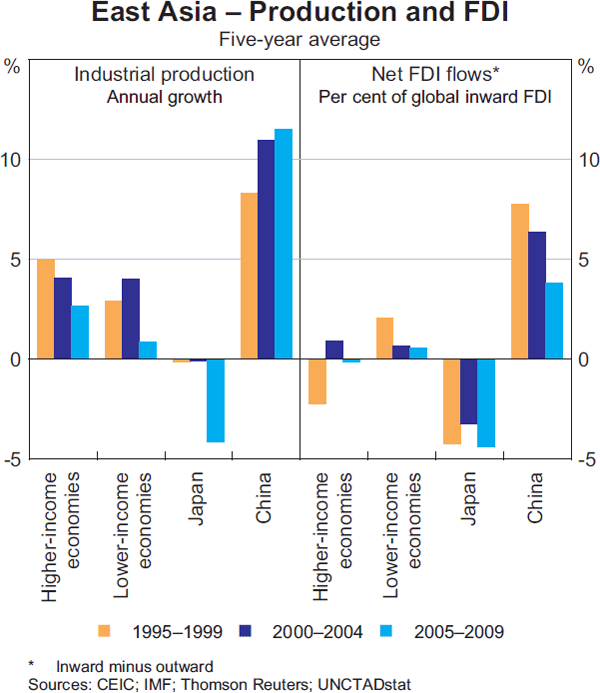
While China and other lower-income economies are attracting foreign direct investment from developed economies outside the region, a large share also comes from other Asian economies. Faced with rising costs of production in their home markets, firms in Japan, Korea and Taiwan have increasingly been looking to outsource production to the lower-income (and hence lower-wage) economies in the region, often by setting up subsidiaries in those countries. This raises the question of the extent to which the growth in manufacturing in the lower-income Asian economies (including China) reflects a shift in production away from the higher-income economies in the region. This has implications for assessments of trend rates of growth in individual economies in east Asia, as well as for the region as a whole. This article explores this question in more detail, looking at how production in east Asia has shifted geographically over time, and examines evidence about the extent to which this shift in production has resulted in the loss of some manufacturing capacity in the higher-income economies.
Factory Asia
Global supply chains involve the production of different components across multiple economies, some of which cross national borders multiple times, with final assembly in one country drawing these components together (Riad et al 2012). The supply chains in Asia are widely considered to be among the more complex in the world. There are extensive cross-country production networks, particularly in the automotive and information and communication technology (ICT) sectors. While China accounts for around half of the region's exports of final goods, these supply chains effectively spread the value-added contribution of these goods over many economies. The chains have developed over more than 30 years, with production gradually spreading from the higher-income economies in the region to the lower-income economies, and they continue to develop today.
Historically, Japan was the first economy in the Asian region to develop its manufacturing sector on an industrial scale, and remains a significant driver of many production processes in the region. This began in the mid 1950s, as coordinated investment in infrastructure and physical and human capital combined with the diffusion of foreign technology. Over the subsequent 20 years real per capita GDP increased by around 400 per cent, while exports grew at a faster pace.
The development of supply chains in the east Asian region, however, began in the 1980s, as the competitive advantages of Japanese firms began to wane and they looked to reduce production costs by moving some production processes offshore. This first wave of ‘offshoring’ was concentrated in Hong Kong, Singapore, South Korea and Taiwan, where labour costs were relatively low. The labour-intensive, ‘low-tech’ processes moved offshore first, with the ‘high-tech’ processes remaining. Once these economies developed, and labour and other costs began to rise, Japanese firms, and others that had started up in these economies, looked to move production to other lower-income economies in east Asia to contain costs.[2]
This gradual shift in production in Asia from higher-income economies to lower-income economies was enhanced by a number of other changes in the region throughout this period. Up until the early 2000s, real transport costs had been falling in trend terms since at least the mid 1980s. Further, trade barriers in east Asia have gradually been reduced, with a noticeable decline in average applied tariffs in the early 1990s around the time that the Association of South East Asian Nations (ASEAN) – then comprising Indonesia, Malaysia, the Philippines, Singapore and Thailand – implemented a free trade agreement.[3]
The shift in production across east Asian economies is reflected in net FDI by country. Japan has had a net outflow of FDI since at least the 1970s (Table 1).
| Per cent of global inward FDI | Per cent of economy's GDP |
||||
|---|---|---|---|---|---|
| 1970s | 1980s | 1990s | 2000s | 2000s | |
| China | – | 1.6 | 6.9 | 5.1 | 2.4 |
| Hong Kong | 1.0 | 1.0 | −2.6 | 0.0 | 0.1 |
| Indonesia | 1.9 | 0.4 | 0.5 | 0.0 | −0.1 |
| Japan | −5.7 | −12.1 | −8.6 | −3.8 | −1.0 |
| Malaysia | 1.3 | 1.0 | 1.3 | 0.0 | −0.1 |
| Philippines | – | 0.3 | 0.3 | 0.1 | 1.0 |
| Singapore | 1.0 | 1.9 | 1.2 | 0.9 | 6.9 |
| South Korea | 0.5 | −0.1 | −0.3 | −0.2 | −0.3 |
| Taiwan | 0.3 | −0.3 | −0.6 | −0.4 | −0.9 |
| Thailand | 1.0 | 0.5 | 0.8 | 0.5 | 3.0 |
|
(a) Inflows minus outflows Sources: RBA; UNCTADstat |
|||||
FDI outflows from South Korea and Taiwan have also gradually increased, both having moved from being net recipients of FDI flows to net investors in the 1980s. In contrast, Singapore continues to receive large inflows of FDI (as a share of global inflows as well as relative to Singapore's own GDP), while inflows to Hong Kong are also generally positive. This is likely to reflect these economies' positions as key transport hubs in the region, with investment inflows reflecting the growth of trade in the region in general, which is positively correlated with the increasing complexity of supply chains (Craig, Elias and Noone 2011). FDI has also been increasing in many of the lower-income economies in the region. This is particularly apparent for China, which now accounts for around two-thirds of net FDI inflows into east Asia. Net flows into Indonesia, the Philippines and Thailand have also been increasing, although flows into Malaysia have recently declined.
The increasing importance of China and the other lower-income economies in the region can be clearly seen in Japanese FDI data. Following a period of strong investment outflows to other economies in east Asia in the 1970s and 1980s, Japanese FDI to China began to grow strongly around the mid 1990s, at around the time that the magnitude of outflows to the US and some other advanced economies began to decline. China has received more investment from Japan than either the higher-income or the lower-income economies in east Asia since the early 2000s, and now accounts for around one-third of new Japanese investment in Asia (Graph 2). More detailed data, which are only available from 2005, suggest that growth in Japanese FDI to China has been strongest in the manufacturing sector, with China now accounting for close to 40 per cent of Japanese manufacturing investment in Asia. FDI has financed growth in Japanese subsidiaries in China and the other lower-income economies in the region. Subsidiaries in China now account for almost one-quarter of all Japanese foreign subsidiary sales and the other lower-income economies a further one-quarter (Graph 3).
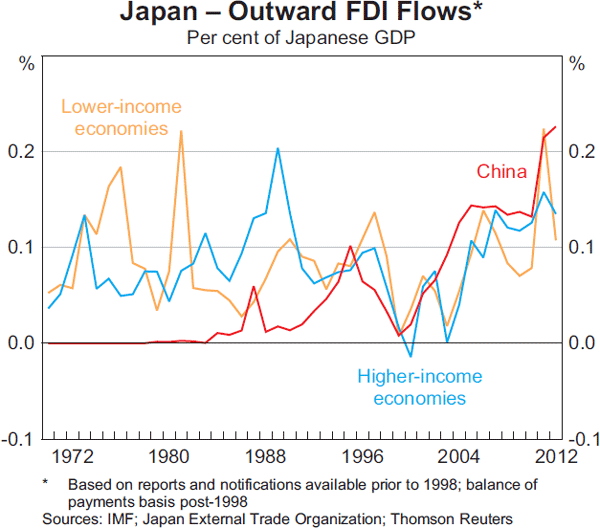
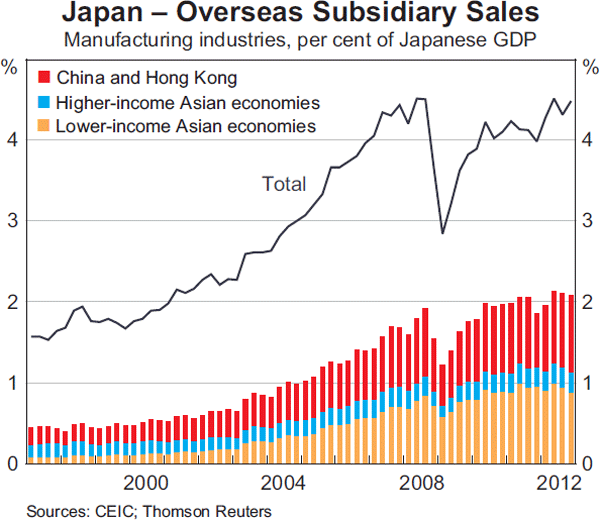
Geographical Shifts in Production: Mid 1990s to Mid 2000s
The development of east Asian supply chains can be seen by examining how total value added has shifted across the region. Value added is the amount by which the value of a product is increased at each stage of production, excluding the value of intermediate inputs to that good. Considering movements in value added, rather than trade flows, accounts for the fact that various components of a single final good may be produced in different countries.
This article uses a broader measure of value added than that provided in national accounts data. This measure includes all the value that is added domestically to a good produced by an industry, and we call this ‘total value added’. To calculate this, input-output tables are used for the seven economies in the region for which data are available.[4] As an example of how total value added is calculated, consider the production of a car. The value added by the car industry, as measured in the national accounts, is equal to the value of the car, minus the value of the rubber for the tyres, the steel used to create the body, and the value of all other inputs from different industries. If the steel, rubber, and other supporting industries are located domestically, the total value added to the car domestically will be substantially larger than the value added just by the motor vehicle industry itself. This is because total value added accounts for the activity in the rubber and steel industries (as well as in industries that provide inputs to those rubber and steel products) that would not take place if the car were not produced.[5] However, note that owing to data limitations, total value added does not include any domestic content in imported inputs where the reimported good is in a different industry from that of the initial value added.[6] For further details on methodology, see Chen et al (2012) and Rayner and Bishop (2013).
Looking at the manufacturing industry as a whole, the results are consistent with the evidence outlined above about the shift of manufacturing from Japan and the higher-income economies in the region into China and the other lower-income economies from the mid 1990s. Japan contributed around 65 per cent of the total value added in the region to final manufactured goods in the mid 1990s (Table 2).[7] China accounted for about 15 per cent of regional value added at that time, but manufacturing value added in China has grown rapidly since then and accounted for around 35 per cent of regional value added in the mid 2000s. This has corresponded with a decline in Japan's share, to around 40 per cent. The share of total value added in all other economies has remained little changed.
| Mid 1990s | Early 2000s | Mid 2000s | |
|---|---|---|---|
| Japan | 67.2 | 55.5 | 41.1 |
| China | 14.5 | 25.0 | 36.3 |
| South Korea | 7.1 | 8.6 | 10.8 |
| Taiwan | 4.1 | 4.0 | 4.0 |
| Indonesia | 2.9 | 2.4 | 3.1 |
| Thailand | 2.3 | 2.7 | 2.8 |
| Malaysia | 1.9 | 1.9 | 1.9 |
|
Sources: Bank of Korea; Department of Statistics (Malaysia); IMF; National Economic and Social Development Board (Thailand); OECD; RBA |
|||
The strong growth in production in China has been driven in part by strong growth in Chinese domestic demand. This can be seen by China's share of the region's domestic final demand for manufactured goods increasing rapidly over the past two decades, bringing it closer to its share of the region's total value added in manufacturing. However, it is clear that increased production in China also reflects increased integration into regional supply chains: total value added in manufacturing continues to exceed domestic final demand for manufactured goods, both in levels and as a share of the region. Further, over the first half of the 2000s, total manufacturing value added grew faster than domestic final demand for manufactured goods, suggesting that China's production growth represents an increased importance in regional supply chains within this period.
The decline in Japan's share of the region's total value added and the rising share of China can also be seen in the total value added data for the region's two largest industries, transport equipment and electronics. Japan accounted for around 70 per cent of regional total value added in each of these industries in the mid 1990s, while China accounted for around 8 per cent (Table 3). By the mid 2000s, Japan accounted for around 55 per cent of total value added in the transport industry and 40 per cent of total value added in the electronics industry. This suggests that the shift of production locations in the electronics industry has led to a larger relative decline in Japanese manufacturing than the shift in the transport industry.[8]
| Transport Equipment Share of region, per cent | |||
|---|---|---|---|
| Mid 1990s | Early 2000s | Mid 2000s | |
| Japan | 68.1 | 62.9 | 54.9 |
| China | 9.4 | 18.2 | 21.3 |
| South Korea | 10.4 | 10.1 | 14.6 |
| Thailand | 2.8 | 1.9 | 3.0 |
| Indonesia | 2.1 | 1.5 | 3.0 |
| Taiwan | 4.9 | 3.0 | 2.2 |
| Malaysia | 2.4 | 2.4 | 1.0 |
| Electronics Share of region, per cent |
|||
| Mid 1990s | Early 2000s | Mid 2000s | |
| Japan | 74.5 | 57.0 | 40.2 |
| China | 6.8 | 20.2 | 27.7 |
| South Korea | 8.9 | 12.3 | 15.0 |
| Taiwan | 6.6 | 6.6 | 10.4 |
| Thailand | 2.0 | 2.2 | 3.4 |
| Indonesia | 0.5 | 0.9 | 1.8 |
| Malaysia | 0.7 | 0.7 | 1.4 |
|
Sources: Bank of Korea; Department of Statistics (Malaysia); IMF; National Economic and Social Development Board (Thailand); OECD; RBA |
|||
Japan's share of total value added in the transport industry is noticeably larger than its share of gross output, highlighting its important role in supplying regional production networks with high-tech components. Reflecting this, Thailand's share of total value added in the transport industry is below its share of regional gross output. This owes to the large share of intermediate inputs from other economies in the region used by manufacturers in Thailand, particularly from Japan.
Most economies' domestic content of production has declined over time (Graph 4). This reflects the specialisation in parts of the value chain in each country and the growth in intraregional production links. Japan's total domestic value added content in a unit of final demand for manufactured goods remains the highest in the region, at around 80 per cent, but this has declined from around 90 per cent in the mid 1990s. While China's total domestic value added content was quite high in the mid 1990s, at around 80 per cent, this has since fallen to around 70 per cent. Thailand and Malaysia have the lowest total domestic value added content of production, at around 40 per cent. Relative to the other lower-income economies (outside China), Indonesian production has high domestic content, which may be due to its low trade openness, as measured by its low and declining level of trade as a share of GDP, and its lesser integration in regional supply chains.

Input-output data also allow us to decompose total domestic value added into its industry sources for each unit of production for a particular industry. Using this information, we can gain further understanding of how economies specialise in the production process. Across the major industries, Japan has the largest share of manufacturing total value added that comes from research and development, at between 6 to 7 per cent. This share has increased over time, suggesting that Japan has specialised in research and development, while moving lower-skill tasks offshore.
On the other hand, in China, Malaysia and Thailand the own-industry value-added contributions from the electronics and transport industries were the lowest in the region, and have been declining since the mid 1990s. This suggests that lower-skill tasks in these industries, such as final assembly, have been moved to these countries. Further, in the transport equipment industry, around 25 per cent of Thailand's total value added comes from basic metals.
The input-output methodology can also be used to examine the total value added for exports of goods in a particular industry.[9] Looking at production for export, China's share of the region's total value added in the transport equipment industry has remained low, growing from around 6 per cent in the mid 1990s to 12 per cent in the mid 2000s. In contrast, Korea's share has doubled from 10 per cent to 20 per cent, and Japan's share, though still high, has decreased from 75 per cent to 60 per cent of the region (Table 4). This suggests that the strong growth in Chinese manufacturing of transport equipment has been largely to keep up with growing domestic demand. Conversely, in the electronics industry, Japan's share of total value added in the region that is exported has halved, from 60 per cent in the mid 1990s to 30 per cent in the mid 2000s. This fall has been mostly offset by larger increases in the shares of South Korea and Taiwan, which have smaller, but more export-oriented electronics industries than Japan. China's share of electronics production that is exported is broadly in line with its share of production for final demand (Tables 3 and 4).
| Transport Equipment Share of region, per cent | |||
|---|---|---|---|
| Mid 1990s | Early 2000s | Mid 2000s | |
| Japan | 75.7 | 82.7 | 61.5 |
| South Korea | 10.5 | 0.2 | 19.9 |
| China | 6.4 | 9.9 | 12.3 |
| Thailand | 2.2 | 1.7 | 2.5 |
| Taiwan | 3.8 | 3.8 | 2.4 |
| Indonesia | 0.7 | 1.2 | 0.9 |
| Malaysia | 0.6 | 0.6 | 0.5 |
| Electronics Share of region, per cent |
|||
| Mid 1990s | Early 2000s | Mid 2000s | |
| Japan | 61.6 | 50.0 | 31.6 |
| China | 8.2 | 18.6 | 27.3 |
| South Korea | 11.3 | 6.3 | 16.1 |
| Taiwan | 10.5 | 11.9 | 14.1 |
| Malaysia | 8.1 | 8.1 | 6.1 |
| Thailand | 0.4 | 3.5 | 3.7 |
| Indonesia | 0.5 | 1.5 | 1.1 |
|
Sources: Bank of Korea; Department of Statistics (Malaysia); IMF; National Economic and Social Development Board (Thailand); OECD; RBA |
|||
Recent Developments
Input-output data are published with a considerable time lag, so a comprehensive analysis of recent trends in value added in the region is not possible. However, at an aggregate level, industry value added data are available in national accounts. While these data only capture value added directly by an economy's manufacturing industry, giving a different measure of the size of the manufacturing sector in each economy, the same trends are evident. This implies that the national accounts data are likely to provide a good indication of recent trends.
National accounts data show that the same trends described above have continued since the mid 2000s. In particular, China's share of manufacturing value added in the region has continued to increase, and this has been largely due to strong growth in China and no growth in Japan (Graph 5). Manufacturing value added in other economies in the region has also grown, but very strong growth in China has meant that their share of the region has decreased.
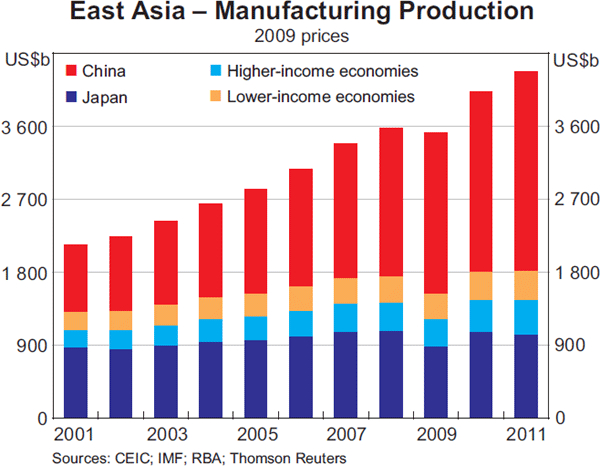
The continued shift of production into China is remarkable, both in recent years and over a longer horizon. While this can largely be seen as a continuation of the development process in China, it is interesting that the shift has been much more pronounced in the electronics industry than in some other industries such as transport equipment. This is likely to reflect the rapid changes in technology and associated changes in consumer preferences in the ICT industry, which have been faster and more widespread than changes in many other industries. When there is a high degree of ‘creative destruction’ in an industry, there is some evidence that incumbent firms are less able or willing to innovate, and thus new products from smaller, less dominant firms become a substitute for existing products (Igami 2013). Even when incumbent firms are driving the technological changes, more of the value of a product is likely to be added in the most competitive country in the region when that product is new, since there is no legacy of existing supply chains. The emergence of electronic tablets is a good example of this, with anecdotal evidence suggesting that a large share of this product is assembled in China. Other changes that have benefited China's ICT industry are the growing market share of Apple smartphones, from 9 per cent in 2008 to 19 per cent in 2012, which reportedly have more components made in China than some other previously popular brands, and the switch in preferences from desktop computers to laptops, since around 80 per cent of global laptop exports are from China. With many electronic components also increasingly coming from China, China's total value added in the electronics industry is expected to continue to increase.
Future Trends
The past two decades have seen an extraordinary expansion of production in China, increasing that country's share of regional value added from around 15 per cent in the mid 1990s to 35 per cent in the mid 2000s. Strong growth in the rest of the region and a contraction of the manufacturing total value added in Japan has meant that Japan's share of regional value added has declined since the mid 1990s. The extent to which this shift can continue remains an open question. As coastal regions in China have developed, and wages and other costs have started to rise, production has gradually moved inland. Given China's size, in terms of both its population and geography, there is still some way to go for this move of industry into regional areas. There also appears to be some shift of production into other low-cost economies in the region. High inflows of FDI into Cambodia, Laos and Vietnam in recent years have been accompanied by rapid growth in exports, although in absolute terms these flows are still very small (Graph 6). As costs increase in China, it seems likely that this shift into other low-cost economies in the region will continue.
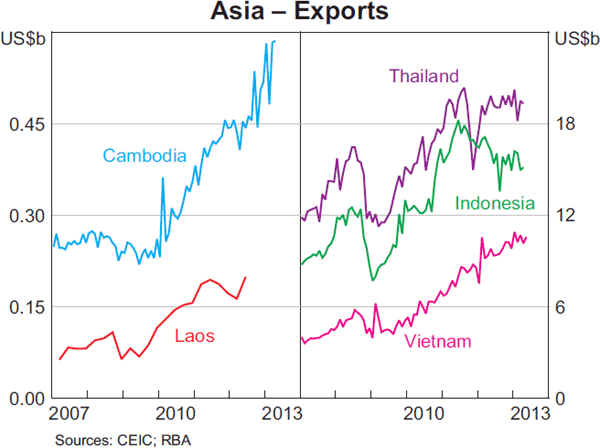
In contrast to the broader trend for production to move where costs are lower, there have been some recent anecdotal reports of firms moving production back to higher-income economies. For example, in the United States, General Electric reopened local facilities to produce water heaters and refrigerators last year, while Apple has announced plans to move production of an existing product to the United States. Firms cite increasing transportation costs, lower energy costs in the United States and increasing wages in China as reasons for such moves. Also, some claim that significant efficiency gains can be made by locating production closer to research and development centres. So far, this has only occurred for certain high-tech, capital-intensive products, and it is difficult to know how widespread this practice may become. Reflecting similar factors, there is some speculation that firms will also move more production to lower-cost countries closer to home than Asia, such as Mexico for US firms. Nonetheless, it seems likely that Asia (and particularly China) will remain the world's factory for some time yet, at least as long as it retains its low-cost advantage.
Footnotes
The authors are from Economic Analysis Department. [*]
In this article, ‘higher-income economies’ refers to Hong Kong, Singapore, South Korea and Taiwan and ‘lower-income economies’ refers to Indonesia, Malaysia, the Philippines and Thailand. [1]
This progressive development process was formalised by Akamatsu (1962) and is called the ‘Flying Geese Model’, to reflect its similarity to the formation of a flock of flying geese, with one leader and other geese following the same path behind. For an interpretation of this model in the wider context of east Asia, see Kojima (2000). [2]
These countries were subsequently joined by Brunei, Cambodia, Laos, Myanmar and Vietnam. ASEAN also has separate free trade agreements with Australia, China, India, Japan, New Zealand and South Korea. [3]
The dataset consists of input-output tables for China, Indonesia, Japan, Malaysia, South Korea, Taiwan and Thailand, with three observations: the mid 1990s, the early 2000s and mid 2000s. These data are available from the OECD or from national sources. Tables for Malaysia are not available for the mid 1990s, so Malaysia's share of value added is assumed to be the same in the mid 1990s as it was in the early 2000s. [4]
Of course, individual industry value added calculated in this way cannot be summed, since there would be substantial double counting. [5]
For example, if China exports steel to Japan, Japan uses the steel to make part of a car, and then exports that part to China for final assembly, the value added in the Chinese steel industry will not be counted in China's total value added to the car. However, if the part were made in China, not Japan, the steel production would be counted in China's total value added. [6]
Note that the value added in the region will not equal the value of gross output, since it does not capture the value of intermediate inputs produced outside the region. [7]
This may or may not be true for Japanese firms, since firms could have increased profits by shifting production offshore. [8]
This is calculated by multiplying the total value added in an industry by the share of final demand for exports, which assumes that manufactured goods for export and for domestic use are produced using the same production technology. This is quite a strong assumption, particularly for countries such as China, Indonesia and Malaysia which have special economic zones where export-oriented production takes place. [9]
References
Akamatsu K (1962), ‘Historical Pattern of Economic Growth in Developing Countries’, The Developing Economies, 1, pp 3–25.
Chen X, L Cheng, K Fung, L Lau, Y Sung, K Zhu, C Yang, J Pei and Y Duan (2012), ‘Domestic Value Added and Employment Generated by Chinese Exports: A Quantitative Estimation’, China Economic Review, 23, pp 850–864.
Craig A, S Elias and C Noone (2011), ‘Destinations and Uses of East Asian Merchandise Exports’, RBA Bulletin, June, pp 9–14.
Igami M (2013), ‘Estimating the Innovator's Dilemma: Structural Analysis of Creative Destruction’, 30 May. Available at <http://dx.doi.org/10.2139/ssrn.1733174>.
Kojima K (2000), ‘The “Flying Geese” Model of Asian Economic Development: Origin, Theoretical Extensions, and Regional Policy Implications’, Journal of Asian Economics, 11(4), pp 375–401.
Rayner V and J Bishop (2013), ‘Industry Dimensions of the Resource Boom: an Input-Output Analysis’, RBA Research Discussion Paper No 2013-02.
Riad N, L Errico, C Henn, C Saborowski, M Saito and J Turunen (2012), Changing Patterns of Global Trade, Departmental Paper No 12/1, International Monetary Fund, Washington DC.